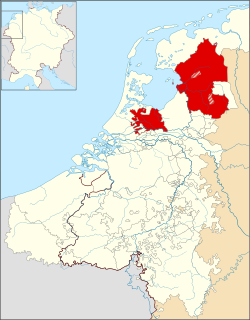
Back أسقفية أوترخت Arabic Utrechtské knížecí biskupství Czech Utrecht bispedømme Danish Hochstift Utrecht German Princepiskopujo Utreĥto Esperanto Principauté d'Utrecht French Prinsbisdom Utert Frisian Keuskupan Utrecht ID Principato vescovile di Utrecht Italian 위트레흐트 주교후국 Korean
This article needs additional citations for verification. (September 2014) |
Prince-Bishopric of Utrecht Sticht Utrecht (Dutch) | |||||||||||
|---|---|---|---|---|---|---|---|---|---|---|---|
| 1024–1528 | |||||||||||
 Bishopric of Utrecht c. 1350. Nedersticht is the smaller territory while Oversticht is the larger territory. | |||||||||||
| Status | State of the Holy Roman Empire | ||||||||||
| Capital | Utrecht | ||||||||||
| Common languages | Middle Dutch, Middle Low German | ||||||||||
| Religion | Roman Catholicism (State religion) | ||||||||||
| Government | Ecclesiastical principality | ||||||||||
| Prince-bishop | |||||||||||
• (1024–1026)[a] | Adalbold II of Utrecht | ||||||||||
• (1524–1528)[b] | Henry of the Palatinate | ||||||||||
| Historical era | Middle Ages | ||||||||||
• Lower Lotharingia divided from Lotharingia | 959 | ||||||||||
• Established | 1024 | ||||||||||
| 1075–1122 | |||||||||||
| 1122 | |||||||||||
• Joined the Burgundian Circle | 1512 | ||||||||||
| 1502–1543 | |||||||||||
• Disestablished | 1528 | ||||||||||
• Union of Utrecht signed | 1579 | ||||||||||
| |||||||||||
| Today part of | Netherlands | ||||||||||
The Bishopric of Utrecht (Dutch: Sticht Utrecht) was an ecclesiastical principality of the Holy Roman Empire in the Low Countries, in the present-day Netherlands. From 1024 to 1528, as one of the prince-bishoprics of the Holy Roman Empire, it was ruled by the bishops of Utrecht.
The Prince-Bishopric of Utrecht is not to be confused with the Diocese of Utrecht, which covered a larger area. Over the areas outside the Prince-Bishopric, the bishop exercised only spiritual, not temporal, authority.
In 1528, Charles V, Holy Roman Emperor secularized the Prince-Bishopric, depriving the bishop of its secular authority.
Cite error: There are <ref group=lower-alpha> tags or {{efn}} templates on this page, but the references will not show without a {{reflist|group=lower-alpha}} template or {{notelist}} template (see the help page).
© MMXXIII Rich X Search. We shall prevail. All rights reserved. Rich X Search

